MINIX has just launched a new Windows 10 mini PC with MINIX NEO Z83-4 powered by an Intel Atom x5-Z8300 quad core processor, 4GB RAM, 32GB storage, Gigabit Ethernet, 802.11ac WiFi, etc.. The company sent me an early review sample, and today I’ll go through the specs, take pictures of the device and accessories, and tear it down to check out the PCBA, and the thermal design.
MINIX NEO Z83-4 Specifications
MINIX latest mini PC has slightly higher-0end specifications that most X5-Z8300 computers or sticks:
- SoC – Intel Atom x5-Z8300 “Cherry Trail” quad core processor @ 1.44 GHz / 1.84 GHz (Turbo) with Intel Gen8 HD graphics (2W SDP)
- System Memory – 4GB DDR3L
- Storage – 32 GB eMMC 5.0 flash + micro SD slot
- Video Output – HDMI 1.4 and mini DP up to 4K @ 30 Hz
- Audio I/O – HDMI, 3.5mm earphone jack
- Connectivity – Gigabit Ethernet, dual band 802.11 b/g/n/ac Wi-Fi, and Bluetooth 4.2
- USB – 3x USB 2.0 host ports, 1x USB 3.0 port supporting phone charging while the PC is turned off
- Misc – Power button and LED, RTC battery, Kensington lock ready
- Power Supply – 12V/3A
- Dimensions – 12.8 x 12.8 x 2.75 cm
- Weight – 350 grams
The mini PC runs Windows 10 Home with a proper license from Microsoft. The BIOS / UEFI also supports Wake on LAN, auto power recovery after power loss, and scheduled power on. Support for Apple/Nokia/Samsung standard headphones for audio input and output can also be enabled or disabled in the BIOS.
The hardware specifications are somewhat similar to Tronsmart Ara X5 Plus, except NEO Z83-4 has more memory (4GB vs 2GB), a mini DisplayPort output, one more USB 2.0 port, support for Gigabit Ethernet, and a more powerful power supply.
MINIX NEO Z83-4 Unboxing
The retail looks basically the same as I got with MINIX NGC-1.
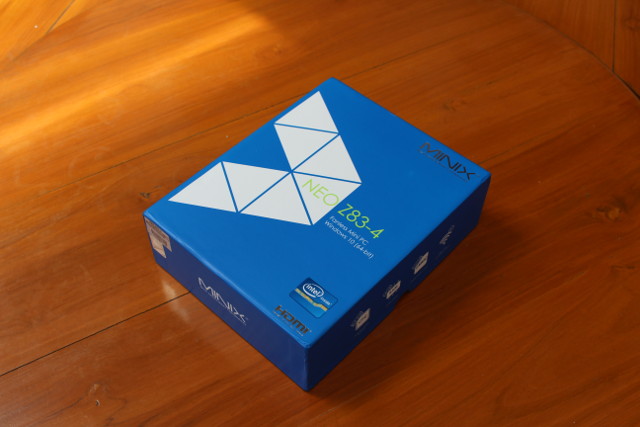
The bottom of the package lists the specifications, and provides links to MINIX Facebook page, and MINIX forums.
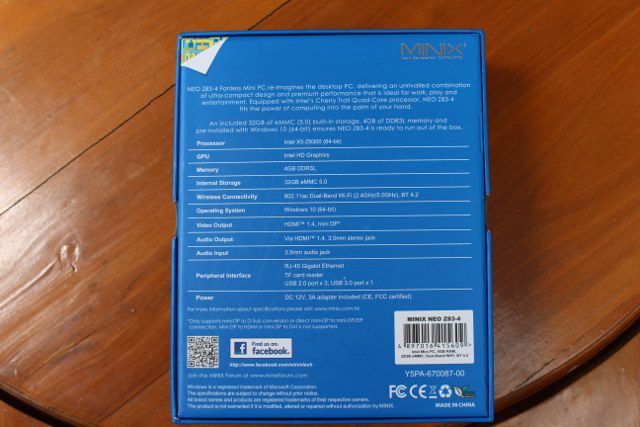
The computer ships with a 12V/3A power supply made by Delta Electronics and corresponding power cord, a WiFi antenna, and HDMI cable, a user’s manual in English and Chinese, and MINIX products brochure.
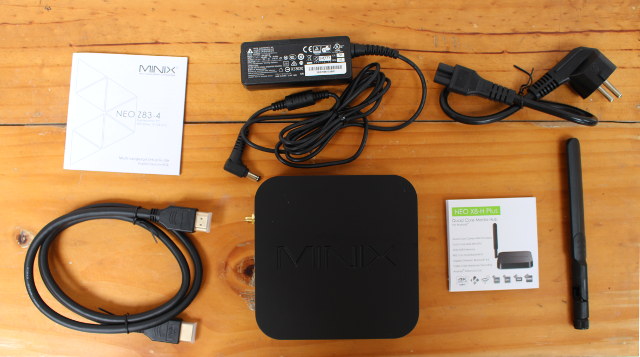
The device looks basically the same as all other MINIX Android TV boxes and mini PCs. One side comes with the power button, the micro SD slot, three USB 2.0 ports, and one USB 3.0 port with the latter also working in power off mode if you want to charge your phone or tablet. The side features the WiFi antenna connector and a Kensington lock opening.
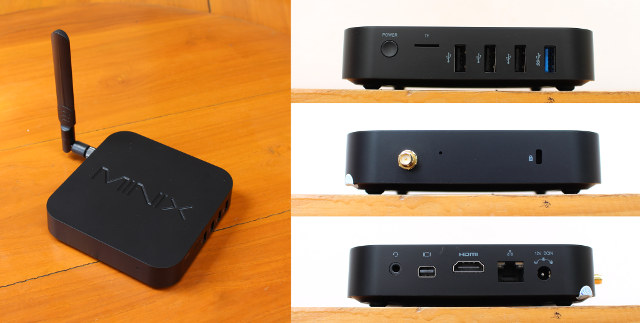
Media and networking ports can be found in the rear panels with a 3.5mm audio jack (microphone + headphone), a mini DisplayPort connector, HDMI 1.4 output, a Gigabit Ethernet RJ45 port, and the power jack.
MINIX NEO Z83-4 Teardown
In order to open the case, I had to remove four sticky pads on the pad, and loosen four screws.
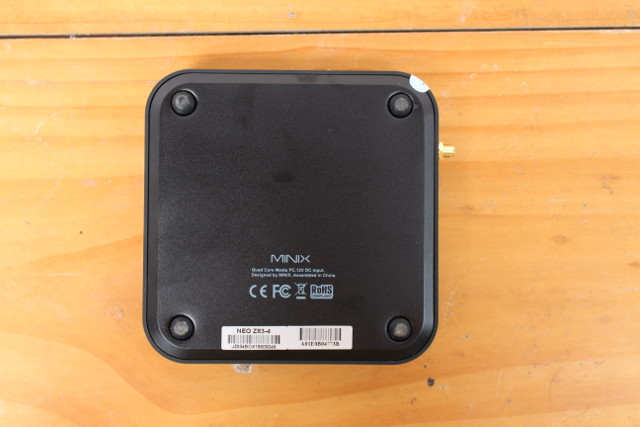 The bottom cover will then come off relatively easily with some gentle taps on the top.
The bottom cover will then come off relatively easily with some gentle taps on the top.
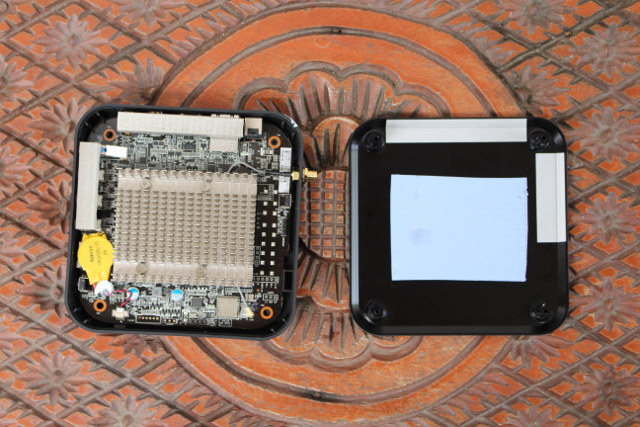
MINIX has got serious with cooling, as they’ve selected a massive heatsink that also in contact with the large thermal pad on the top of the aluminum case. The company also showed me the system running OCCT for four hours last month, so the performance should be very stable, and CPU throttling not an issue. That’s something I’ll have to test in the second part of the review anyway.
I’ve removed the heatsink, which was firmly hold in place with four screws and springs. There’s also a thermal pad with some thermal paste under the heatsink to cover the processor.
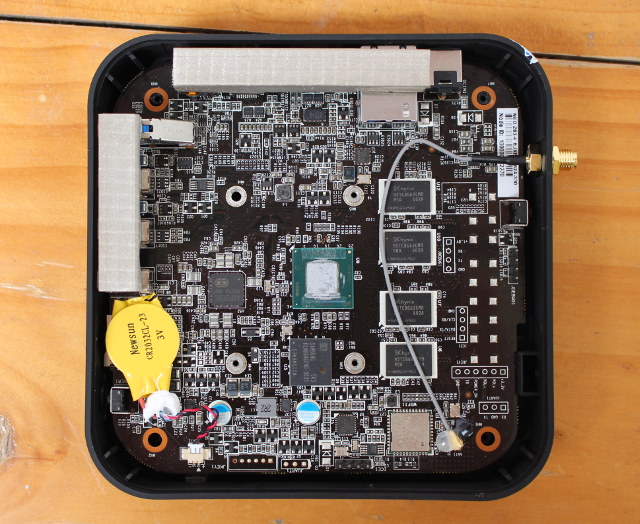
A 32GB Samsung KLMBG4GEND-B031 eMMC 5.0 flash with 250 MB/s read speed, 100 MB/s write speed, and 6000/12000 R/W IOPS is used together with four SKhynix H5TC8G63CMR-PBA DDR3L @ 1600 MHz SDRAM (4GB in total) for storage and memory. Ampak AP6255 module delivers WiFi 802.11 b/g/n/ac and Bluetooth 4.2? LE wireless connectivity, while a Realtek RTL8711GS PCIe to GbE transceiver allows for Gigabit Ethernet, with the transformer likely inside the Ethernet RJ45 connector. Other ICs includes AXP288C PMIC, and two smaller chip marked “MINI5BZDE 539GB 2532B076 ZZ ARM” and “B203 A3 UBCUC D8P8J 1522”, but I could not figured out what they could be used for. One of them is likely the MCU taking care of the power circuitry. You’ll also notice the RTC battery, and two headers marked ICE1 and JDEBUG1 which could be useful in the unlikely case the mini PC is bricked.
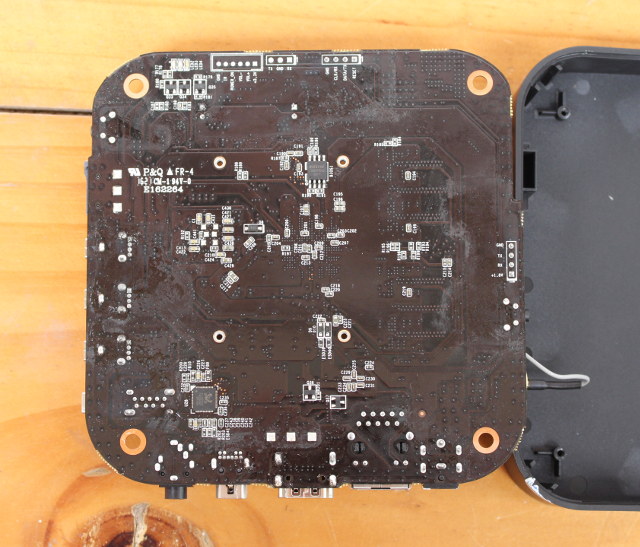
The bottom of the board features Realtek ALC5645 audio codec, and Winbond 25Q64FWSIG 64Mbit SPI flash.
This looks all good, but what about price? The previous model, MINIX NGC-1, did not become that popular despite a very good implementation due to its high price, partially because of the $85 Windows 10. MINIX NEO Z83-4 mini PC is priced rather competitively, as it will sell for $169.90 US, 169.90 Euros, or 144.90 GBP depending on the country starting on September 16th.
[Update: MINIX NEO Z83-4 mini PC Review Part 2 is up].

Jean-Luc started CNX Software in 2010 as a part-time endeavor, before quitting his job as a software engineering manager, and starting to write daily news, and reviews full time later in 2011.
Support CNX Software! Donate via cryptocurrencies, become a Patron on Patreon, or purchase goods on Amazon or Aliexpress




